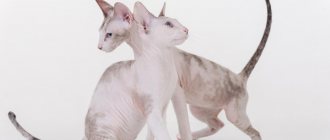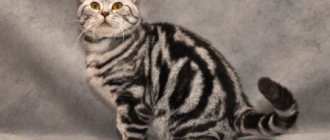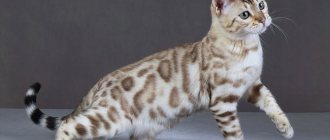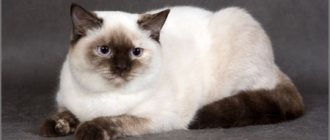Thai cats are beautiful and noble. They have clear and expressive blue eyes, magnificent coloring and gracefulness, which makes the Thai cat the center of attention. The Thai cat originally appeared in Thailand, which is why it got its name. It was bred in Europe by selecting the Siamese breed. As a result, the color, shape and contour of the cat's face, and the structure of the cat's body changed.
The standard for the Thai cat breed was approved in 1990 in Germany. It first appeared on Russian territory in the royal family of Nicholas II as a gift from the Siamese king. Now the Thai cat is among the leaders in popularity.
Thai cat
Description of a Thai
The Thai cat is very similar to the Siamese and they are often confused. However, upon closer examination, differences are noticeable:
- The body of a Thai cat is denser and more massive.
- The shape of the muzzle is round, without the elongation characteristic of Siamese.
- The eye shape is round, without sharp edges.
- The legs are shorter and stronger.
Thais are considered medium-sized cats. They are powerful, graceful and elegant. Cats have a slender build and well-developed muscles. The structure is proportional, with soft contour lines. The short neck is quite muscular.
The head is rounded on all sides. The muzzle is rounded and of medium length. The profile is slightly convex. The nose is in line with the eyes.
The ears end in soft rounding or tassels. They are wide at the base and located closer to the sides. The eyes are set slightly obliquely and far apart.
Exterior
Paws are rounded. The tail is of medium length with a pointed end. The short coat is soft and almost devoid of undercoat. Fits well to the body. The weight of an adult pet is 3-10 kg. The body length is about 30 cm. Life expectancy is on average 10-14 years. Against the background of the general structural features of representatives of the Thai breed, color options can be very different.
Color options
The colors of Thai cats, regardless of shade, correspond to the same pattern, when the body is one light color, and the mask on the face, ears, lower part of the paws and tail are of a different, darker and contrasting tone. This type of color is called color point or Siamese.
The color of a cat changes as it grows. After all, kittens are born completely white. Gradually, shades of the breed appear on the body. The most popular, classic option is the seal-point color. The seal point cat is particularly attractive.
Seal point color
The Thai cat has a body of a basic light cream color with dark brown markings on the limbs and face. Moreover, the muzzle can be almost black. The eye color is bright blue with a glow and penetrating gaze. Disadvantages of the breed include green eyes or light-colored fur on the paws. Defects are dark marks on the stomach, white stripes on the ears or limbs, a crease in the tail, and a sloping chin.
The following color options are registered:
- Chocolate point with a light brown tone on the main body and a hint of chocolate on the limbs, ears, muzzle and tail. The iris of the eyes is blue with a violet tint.
Chocolate color - Blue point has a blue coat on the body and dark gray markings on the legs and face. The nose point and pads are dark slate color. Eye color is deep blue.
- Tabby point is characterized by stripes on the legs, ears and face with a white body.
Tabby point - Lilac point with a cool shade of lilac on the face and legs.
- Cream (cream point) when the coat of a white-cream shade covers the entire body with a darker tone on the face and limbs. Dark colors sometimes have stripes. The nose and pads are pink. The pads may be covered with dark brown spots, similar to freckles.
- White (fawn point) white color is complemented by the gray-blue shades of the mask on the face and the color of the limbs.
- Tortie point color is a combination of shades of white and brown on the body with tortoiseshell shades on the limbs, appearing in a combination of black with gray, cream or red.
- Red point (red point) a red tint is present on the ears, paws, muzzle along with a white-apricot base coat tone on the body. Freckles are possible on pink paws.
Colors of Thai cats
A distinctive feature of the breed is its color-point color. This means that the cat’s paws, tail, muzzle and ears are necessarily painted in a color contrasting with the rest of the body. The color of the main coat should be light - from cream to snow-white. The standard allows 10 color variations:
- Blue Point. The blue color of the markings combines with the cool shade of the body;
- Seal Point. The most common color. Points are dark brown, almost black;
- Cream point. A cat with creamy markings reminiscent of baked milk;
- Red point. Thai cats with markings the color of boiled condensed milk, the body is snow-white;
- Chocolate point. Pronounced dark chocolate markings, the base color is often darkened;
- Torty point. Exotic spotted color of three colors: red, black and white;
- Tabby point. The muzzle, paws and tail are painted with cute stripes. One of the rarest colors;
- Lilac Point. Light gray-blue spots with a milky color to the rest of the body.
The rarest colors - caramel point (light red with white) and fawn point (light gray with a bluish tint to the coat) are especially valuable.
Pet character
Animals of the Thai breed are attached to their owners, they greet you at the doorstep and are sad when they are apart. They are affectionate and flexible. A natural sense of tact helps them catch the owner’s mood and not become annoying.
Friendly creatures treat all family members and other animals well. A gentle character can be disrupted by a bad attitude towards a Thai cat. They can stand up for themselves, reacting to anger and rudeness with aggression.
Intelligence and quick wits help them quickly learn commands when trained. During the training process, pressure should be avoided, to which the Thai breed can respond with aggression.
Thais love to purr and meow and always “keep the conversation going” when communicating. Despite their noble origin, Thai cats successfully catch mice. Kittens are overly active, inquisitive, playful and intelligent. They are endowed with rich facial expressions and can make funny faces. A small pet in the house will require a lot of time for play and care.
Red point
The kitten will need adaptation to the new place. He will not immediately rejoice at his owner, greet him and purr. In a new home, a Thai cat will first explore the entire territory. You should prepare for this and remove valuable items, wires, household chemicals and plants.
Thai cats express their restless and energetic character by playing with their toys. They spend little time sleeping. They choose the highest point in the house for observation and settle down there.
The Thai cat remembers the insult, but is not vindictive. She simply deprives the offender of her favor. Independence and lack of fear are the hallmarks of the Thai cat. Curiosity overcomes even the instinct of self-preservation. The cat is not afraid of heights, fire, or an open front door. This must be taken into account when maintaining and ensuring safety.
Tortoiseshell color
Peculiarities
Characteristic color features of representatives of the breed are:
“Thais” can be solid and spotted, striped and tortoiseshell. Throughout life, the color may change - either become brighter, or, conversely, fade.
The color of a cat depends on genetics. When looking at a newborn kitten, it is difficult to say what kind of tail it will have, since the color will appear as it grows. The breed is known for blooming, which means the kittens are born white and later develop spots. Adult cats can turn completely dark.
The body of a Thai cat is always lighter than the paws, muzzle and tail. The color also depends on the conditions in which the cat is kept and what it eats. If a Thai woman’s diet contains a lot of offal and seafood, then over time she will darken a couple of shades. The same effect will be achieved if the cat lives outside and in the cool.
The most expensive and valuable color of a Thai cat is the one in which the contrast between body tones and points is the strongest. The marks must be uniform and even. Exhibition copies should only be like this.
All representatives of the breed have sky-blue eyes; this trait appears from the moment of birth. Other shades of their eyes are unacceptable, as are inclusions of other shades on blue eyes.
By nature, Thai cats are very active, curious, playful, and funny. They are very intelligent and easy to learn, love to play with their owner, and often involve the whole family in their entertainment . They have excellent intuition and easily find the “key” to the heart of each family member. They are everyone's favorite.
Kittens are extremely curious . They need to crawl into literally every corner, but at the same time not lose sight of the owner. They love to play with bags. As they grow older, they begin to chew on wires, so you need to make sure that this is not accessible to them. This is due to the fact that the teeth itch, and it is very convenient to do this with wires.
Recommendations for keeping the house
It is advisable for the pet to have its own corner with a house and rungs, a scratching post, rungs and hanging toys. The scratching post should be in a place convenient for the cat. The claws need to be monitored and trimmed periodically.
The short hair of the Thai cat does not require special care. It is enough to brush your cat once a week, which your pet will definitely like. To arrange the tray, you need to allocate a place that is secluded and always accessible to the cat.
A small kitten will be better suited for litter with small granules, which will arouse his interest. Until the baby gets used to it, he may refuse to eat. You need to offer him something tasty and leave him in the room so that he doesn’t get scared.
Sterilization of animals at an early age will help protect yourself from the anxiety associated with the “season of love.” Of course, provided that the offspring are unwanted. An uncastrated cat, in the absence of meetings with a cat, marks all objects with a secretion with a specific, persistent odor. If the necessary vaccinations are available, the cat is taken for a walk on a harness. You need to make sure your pet doesn’t eat anything on the street. If the animal is afraid and stressed during a walk, then you should not insist.
Kittens
Nutrition
The feeding place must be permanent. When organizing meals, you should choose a natural diet or ready-made food and stick to one type, without mixing them. Food of any kind should be warm.
A natural diet includes boiled beef and chicken, boiled egg yolks, and low-fat fermented milk products. You should limit your consumption of seafood and liver when eating natural foods. Additionally include vegetables and fruits. Thais often eat them raw. If the pet does not want to eat the vegetables whole, then they are grated on a fine grater and mixed with the meat.
A vitamin complex is periodically added to food. An adult animal needs two meals a day. Babies are fed 5-6 times a day in small portions to replenish energy reserves. Clean water should always be available, especially when using dry food.
Watch the water
Caring for Thai cats
Thai cats are a fairly clean breed, so they won’t cause you much trouble keeping them. To care for the fur, you need to purchase a special brush. Brushing your cat once every couple of weeks is enough. Thais do not like to bathe, so only take them into the bathroom if absolutely necessary: when they are very dirty or to prepare for an exhibition.
Feeding these cats is not particularly difficult. Choose high-quality ready-made food or create a menu of natural food if you have time to cook for your cat. However, it is undesirable to give some foods to a Thai cat, as they cause darkening of the fur. These include liver, seafood, algae and iodine.
All about cats and dogs











